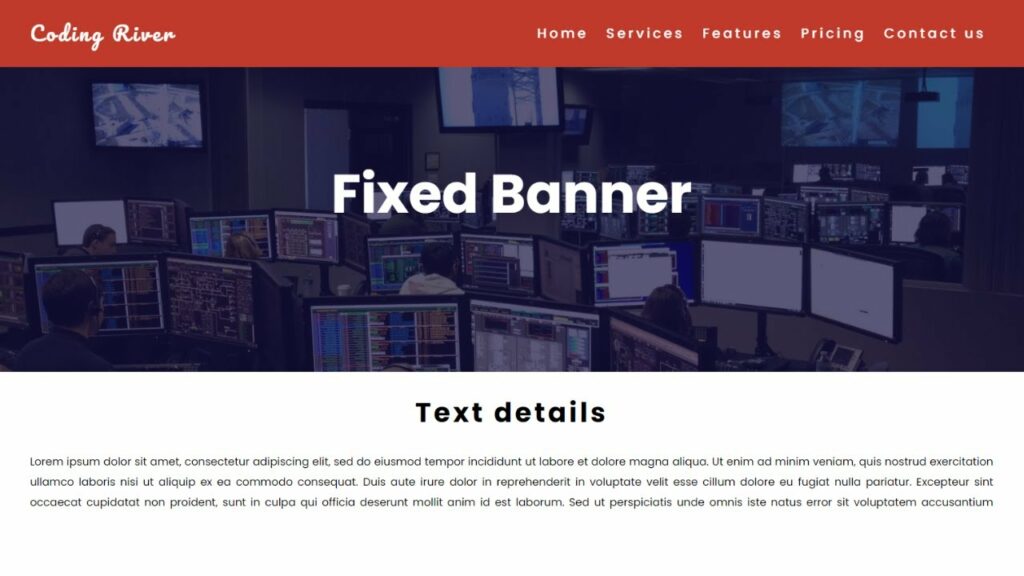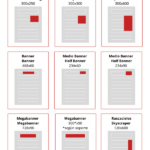
1. The Importance of CSS Banners in Web Design
🚩
CSS banners play a crucial role in web design, providing a visually appealing and informative element to catch the attention of users. When used effectively, these banners can convey important messages, highlight promotions, or guide users towards desired actions. In this article, we’ll explore the significance of CSS banners in web design and why they should not be overlooked.
🏆
One of the key benefits of CSS banners is their flexibility and adaptability. With CSS, designers have complete control over the style, layout, and animations of the banners, enabling them to align perfectly with the overall design aesthetic of the website. This flexibility allows for seamless integration, ensuring the banner becomes an integral part of the website rather than a separated element.
💡
Another crucial aspect of CSS banners is their ability to grab attention and effectively communicate messages. By using eye-catching colors, typography, and animations, designers can create visually appealing banners that compel users to take action. Whether it’s promoting a sale, announcing a new product, or encouraging newsletter sign-ups, CSS banners are an excellent way to convey important information in a visually appealing manner.
📈
CSS banners also contribute to a positive user experience by providing clear guidance and direction. By placing banners strategically, such as at the top of the page or above navigation menus, designers can direct users towards specific content or actions. This helps users navigate the website more easily and increases the chances of them completing desired actions, such as making a purchase or filling out a form.
🌐
In addition to their visual appeal and usability, CSS banners also play a vital role in optimizing websites for search engines. When strategically utilized, banners can contain relevant keywords, meta information, and call-to-action buttons, all of which can contribute to improved search engine rankings. By creating banners that are not only visually appealing but also optimized for SEO, web designers can maximize the visibility and reach of their websites.
🌈
In conclusion, CSS banners are an essential component of effective web design. Their adaptability, attention-grabbing qualities, contribution to user experience, and SEO benefits make them a valuable tool for designers. By incorporating well-designed and strategically placed CSS banners, websites can enhance their overall aesthetic, engage users, and achieve their desired goals.
2. Top Tips to Design Attention-Grabbing CSS Banners
✨🎨💥
When it comes to designing attention-grabbing CSS banners, there are a few key tips that can make all the difference. In this post, we’ll explore five top tips to help you create banners that not only catch the eye but also engage and convert your website visitors.
🔍🚀 First and foremost, it’s essential to have a clear understanding of your target audience. Knowing who you’re designing the banner for will allow you to tailor it to their preferences and capture their attention effectively. Consider factors such as age, interests, and the overall tone and style of your website to create a banner that resonates with your audience.
🌈🖌️ Secondly, make use of color and contrast to make your banner pop. Choose colors that complement your website’s overall design but also stand out and grab attention. Experiment with different color combinations and don’t be afraid to use bold and vibrant hues to draw the eye. Additionally, ensure that the text and visuals on the banner contrast well against the background to ensure readability.
🖍️✂️ Thirdly, keep the design simple and focused. Avoid cluttering your banner with excessive text or too many elements. Instead, opt for a clean and concise design that delivers your message succinctly. Remember, less is often more when it comes to banner design. Use concise phrases or catchy slogans to communicate your key message effectively.
🔮🔥 Fourthly, consider incorporating movement or animation into your CSS banners. Adding subtle animations or transitions can capture attention and create an element of intrigue. However, be cautious not to overdo it, as excessive animation can become distracting and detract from the main message of your banner.
📐📈 And finally, it’s crucial to optimize your banner for different devices and screen sizes. A responsive design ensures that your banner looks great and functions properly across a variety of devices, from desktops to smartphones. Test your banner on different screen sizes to ensure that all the important elements are visible and legible.
By following these top tips, you’ll be well on your way to designing attention-grabbing CSS banners that captivate your audience and drive engagement. Remember to stay true to your brand’s style and message while incorporating these design strategies. Happy designing! 💪🌟
- 📱👨⚕️ Descubre cómo optimizar tu experiencia de atención médica con el Banner Patient Portal
- 🎨 ¡Descubre el impresionante mundo del 🌸 Banner Fu Xuan! ¡Inspírate con diseños increíbles y colores vibrantes! 🖼️💫
- 🎉 ¡Revive la nostalgia con el mejor 🔥 banner de los 80! Descubre los diseños más icónicos y tendencias de la época
- 🎉🌍 ¡Descubre los mejores ✈️ banners para tus viajes! Atrae miradas y planifica tus aventuras con estilo 🌟
- 🎯 ¡Descubre el poder del sensor manual Banner Q4X en español! 🌐
3. Step-by-Step Tutorial: Creating Stunning CSS Banners from Scratch
🖌️ En este artículo vamos a adentrarnos en el apasionante mundo de la creación de banners CSS desde cero. Te llevaré de la mano a través de un tutorial paso a paso para que puedas crear banners increíbles y llamativos para tus proyectos web. ¡Prepárate para impresionar a tus usuarios con diseños únicos!
💡 Antes de comenzar, es importante entender qué es un banner CSS y por qué son tan importantes en el diseño web. Los banners son elementos visuales que se utilizan para destacar información importante o promociones en una página web. Son una excelente manera de captar la atención de los visitantes y transmitir mensajes clave de manera efectiva.
🖥️ Ahora, pasemos a nuestro tutorial. Primero, debemos tener en cuenta que todo banner CSS requiere de un contenedor que englobe el contenido. Este contenedor puede ser cualquier elemento HTML, ya sea una etiqueta
🎨 Para darle estilo a nuestro banner, utilizaremos propiedades CSS como background-color, border, padding, entre otras. También podemos aplicar estilos de texto, como color y tamaño de fuente, para resaltar el mensaje del banner. Recuerda que la clave para un diseño impactante es encontrar el equilibrio entre colores, tipografía y elementos visuales.
✂️ Una forma popular de hacer que los banners sean más llamativos es utilizar transiciones y animaciones CSS. Podemos agregar efectos de desvanecimiento, deslizamiento o rotación para crear una experiencia visual atractiva para los usuarios. No olvides tener en cuenta la usabilidad y la capacidad de respuesta de tu diseño durante el proceso de animación.
4. Best Tools and Resources for CSS Banner Design
🎨CSS Banner Design: Top Tools and Resources
Are you looking to enhance your website or add eye-catching banners and advertisements? Look no further! In this article, we will explore the best tools and resources for CSS banner design. With the help of these tools, you can create stunning designs that will captivate your audience and make your website stand out.
1️⃣ Canva: Known for its easy-to-use design platform, Canva offers a range of templates and design elements specifically for banner design. Whether you’re a beginner or an experienced designer, Canva provides a user-friendly interface and ample customization options to bring your vision to life.
2️⃣ Adobe Photoshop: As a leader in the design industry, Adobe Photoshop allows you to create high-quality, professional banners. With its robust features and extensive toolset, Photoshop provides endless possibilities for design enthusiasts. From layering and gradients to filters and effects, you can unleash your creativity and produce stunning banners that will leave a lasting impression.
3️⃣ CSS Hero: If you’re looking for a tool specifically designed for CSS banner design, CSS Hero is your go-to solution. With its intuitive interface and drag-and-drop functionality, CSS Hero allows you to easily customize banners without writing any code. This makes it an excellent choice for beginners and non-technical users who still want to achieve professional-looking results.
4️⃣ Stock photo websites: When designing banners, having access to high-quality images is crucial. Websites like Unsplash, Pixabay, and Pexels offer an extensive collection of free stock photos that you can use in your designs. From stunning landscapes to vibrant graphics, these platforms provide a vast library of visuals to enhance your banner designs.
5️⃣ CSS banner design tutorials: If you’re new to CSS banner design or looking to expand your skills, online tutorials can be immensely helpful. Websites like W3Schools, CSS-Tricks, and Smashing Magazine offer step-by-step guides, tips, and examples to help you master the art of CSS banner design. By following these tutorials, you can learn new techniques and stay updated with the latest design trends.
In conclusion, when it comes to creating visually appealing banners, having the right tools and resources is essential. Whether you prefer Canva’s simplicity, Adobe Photoshop’s versatility, or CSS Hero’s ease of use, these tools will empower you to create stunning CSS banners that will elevate your website’s design. Don’t forget to leverage the plethora of stock photos available online and continuously improve your skills by following tutorials. Happy designing!
5. The Future of CSS Banners: Trends to Watch Out For
🚩
As an HTML web blogger, I’m excited to delve into the topic of CSS banners and the trends that we should keep an eye on in the future. CSS banners have become an essential element in web design, allowing website owners to communicate important messages effectively. In this blog post, we will explore five key trends that will shape the future of CSS banners.
1. Animation and Interaction: CSS banners are no longer limited to static images or text. In the future, we can expect to see more animated and interactive banners. These banners will capture users’ attention and engage them with captivating visual effects and interactive elements.
2. Responsive Design: With the increasing usage of mobile devices, responsive design has become crucial. CSS banners will adapt seamlessly to different screen sizes and orientations, ensuring a consistent and enjoyable user experience across all devices.
3. Customization and Personalization: Personalization is the key to successful marketing, and CSS banners are no exception. In the future, we can expect to see more banners that are customized based on user preferences or demographics. This will allow website owners to cater to their audience more effectively.
4. Integration with AI and Machine Learning: AI and machine learning technologies are rapidly advancing. In the future, CSS banners may utilize these technologies to analyze user behavior and preferences. This will enable banners to display more relevant and personalized content, leading to higher engagement and conversion rates.
5. Minimalism and Simplicity: In recent years, minimalistic design has gained popularity, and this trend is likely to continue in the future. CSS banners will focus on simplicity, using clean and visually appealing designs that convey the message effectively without overwhelming the user.
6. Augmented Reality (AR): As AR becomes more mainstream, we can expect CSS banners to integrate this technology. AR banners will allow users to interact with products or services virtually, providing a unique and immersive experience.
In conclusion, the future of CSS banners is exciting and holds immense potential. Animation, responsiveness, personalization, AI integration, minimalism, and the incorporation of AR are some of the trends to watch out for. Web designers and marketers should embrace these trends to create engaging, personalized, and effective CSS banners that leave a lasting impression on users. Stay tuned for more updates on the evolving world of web design and CSS banners! ✨
 🎨🖥️ ¡La Herramienta Perfecta! Descubre cómo crear banners impactantes con nuestro Banner Maker fácil de usar
🎨🖥️ ¡La Herramienta Perfecta! Descubre cómo crear banners impactantes con nuestro Banner Maker fácil de usar 🎯🔝 Tipos de Banner: Todo lo que necesitas saber para aprovechar al máximo su potencial publicitario
🎯🔝 Tipos de Banner: Todo lo que necesitas saber para aprovechar al máximo su potencial publicitario 🎨 Descubre los mejores 🖼️ mockups banner 🚀 para destacar en tus diseños
🎨 Descubre los mejores 🖼️ mockups banner 🚀 para destacar en tus diseños 🎨🎉 Increíbles banners en Canva: Cómo crear diseños espectaculares y alcanzar el éxito online 🚀
🎨🎉 Increíbles banners en Canva: Cómo crear diseños espectaculares y alcanzar el éxito online 🚀